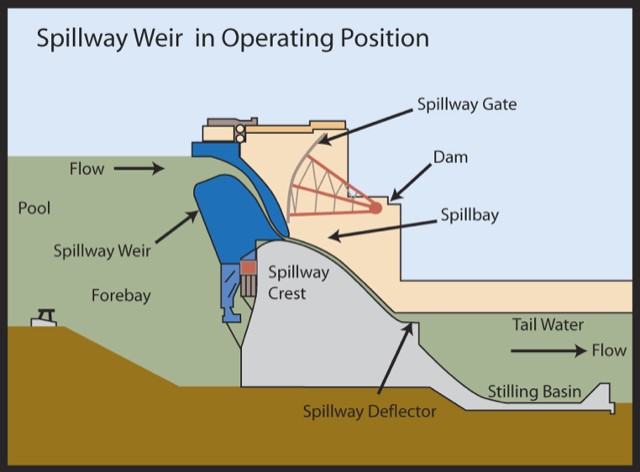Your article about spillway detectors in the April 15 CBB prompts me to write more about spill than my letter to the editor in that same edition.
In the late 90s when we at the Walla Walla District, Corps of Engineers, came up with the concept for making spill safer for fish, our first idea was to dedicate one spill bay for overflow for juvenile fish passage. As stated in my previous letter, this would be more natural like a stream exiting a lake. We thought that one spillway could be raised with concrete to create a 10-foot-deep sill rather than the normal 50-foot-deep spillway sills. However, upper echelons of the Corps insisted that the Standard Project Flood capacity of the dams had to be maintained. At the lower Snake River dams, the SPF is over 800 thousand cubic feet per second. Therefore, our engineers came up with the concept of the removable spillway weir constructed for Lower Granite, Lower Monumental, and Ice Harbor dams. Like a submarine, these massive steel structures can be sunk in the forebay if a never-never-day flood is projected. Like a submarine, compressed air would raise the structure after the flood passed. Since the lower Snake River dams went in, the largest flood has been around 300 thousand cfs, and normal floods are considerably smaller.
Our rough estimate of the cost of a concrete weir and new, smaller tainter gate was around $2 million. The removable spillway weirs have cost around $15 million each. Therefore, if the SPF requirement were waved (as global warming suggests it should be) and the overflow weir concept were properly used, the cost would be much less. Proper use means only one spill bay at the lower Snake River dams, and two at each lower Columbia River dam. The flow would go through the powerhouse unless the flood crest exceeded powerhouse/overflow spillway capacity. Thus, undershot spill would be minimized avoiding added stress and mortality from that passage route and eliminating stress and direct or latent mortality due to elevated dissolved gas levels in over 400 miles of the adult and juvenile fish migration corridor. At Lower Granite dam, one of eight spillway bays has the new PIT tag detectors. Full installation from Lower Granite through Bonneville would require installation on 12 bays, one at each lower Snake River dam, and two at each lower Columbia River dam. The increased income from generation now being wasted with the mass spill program would more than offset the cost of installing PIT tag detectors in 11 more overflow spill bays rather than a total of 116 spillway bays at the eight Snake and Columbia River Corps dams.
Currently the fishery agencies and environmentalists are tinkering with mass spill. This year they will be operating mass spill up to 125 percent TDG, a level that was considered an extinction threat for Columbia and Snake River salmon in the 1970s. Review of recent literature shows that mass spill has reduced the percentage of juvenile fish transported in 2021 to the lowest level since 1993, less than 10 percent. Transport historically provides 98 percent survival. In-river passage typically results in less than 50 percent survival through the system, lower now with the mass spill program.
If the fishery agencies and tribes worked with the Corps to operate the river with overflow weirs, powerhouse collection and bypass systems, and fish transportation, it is clear to me that the smolt portion of SARs would increase substantially. PIT tag detectors on all the overflow weir spill bays in concert with the powerhouse collection system PIT tag arrays would allow monitoring of most juveniles moving downstream whether bypassed or transported. Adults returning through Pit tag detectors already in adult passage systems at the dams, at hatcheries, and on spawning streams would greatly increase the validity of SARs. If the fishery management agencies would reevaluate escapement needs and allow more adults to spawn (more adults in the SARs), then SARs and populations would increase. As it is, when there are large runs predicted, the agencies allow more adults to be harvested compromising SARs and they keep telling the public the dams are the problem.
John McKern
Fish Passage Solutions, LLC
——-
Many Federal reports regarding declining Salmon populations in the Pacific Northwest were published in the late 1800’s; approximately 80 years prior to the construction of the Lower Snake River Dams.
Marshall McDonald’s 1894 report, titled “The Salmon Fisheries of the Columbia River Basin, Report of the United States Commissioner of Fish and Fisheries on Investigations in the Columbia River Basin In Regard to the Salmon Fisheries,
Government Printing Office, Washington D.C.;” states that “the investigations made by Professor Evermann and the parties under his direction establish conclusively the fact that there has been a very great reduction in the number of Salmon frequenting the head waters of the Columbia River and its tributaries.” (Pg 5)
McDonald’s report also states that “they were abundant in the Columbia River at Kettle Falls as late as 1878. Since then there has been a great decrease. They have been scarce since 1882. Since 1890 there have been scarcely any at Kettle Falls.” (Pg 5)
This report also states that “there is no reason to doubt- indeed the fact is beyond question- that the number of Salmon now reaching the head waters of streams in the Columbia River Basin is insignificant in comparison with the number which some years ago annually visited and spawned in these waters.” (Pg 5)
These documented statements were made long before the construction of the Lower Snake River Projects; and hopefully they will be given some consideration as part of the present discussions about the future of these Projects.
Gene R Spangrude
Walla Walla, WA 99362

